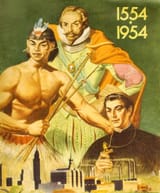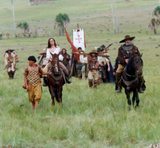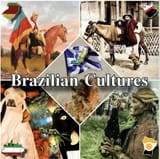>>212423204
Darcy Ribeiro, in his work O Povo Brasileiro, analyzes five regional-cultural identities
>Caipira
Region: Paulistâna.
Origins: bandeirante settlers, later Europeans.
Culture: Rural, agrarian lifestyle, subsistence farming and cattle ranching.
Strong oral tradition, folk tales, music (moda de viola), and festivals.
Resilient and deeply connected to the land.
Darcy Ribeiro’s View: it represents the rural peasantry formed in the expansion inland, marked by isolation and cultural preservation.
>Caboclo
Region: Amazon
Origins: Mix of Indigenous peoples and Portuguese, some African influences.
Culture: River-based and forest-dependent lifestyle
Rich mythology, herbal medicine, and crafts.
Darcy Ribeiro’s View: it embodies the adaptation of Indigenous to colonial pressures
>Gaúcho
Region: Pampas of Rio Grande do Sul.
Origins: Mix of Spanish/Portuguese settlers, Indigenous, and later Europeans
Culture:
Cattle-ranching, horsemanship.
Strong regional identity.
Historically linked to the Farroupilha movement.
Darcy Ribeiro’s View: it represents a frontier culture, shaped by war, cattle economy, and a sense of regional pride.
>Sertanejo
Region: Northeastern dry hinterland.
Origins: Mix of Portuguese, Indigenous, and African influences in a harsh, semi-arid environment.
Culture: Resilient, adapted to droughts.
Cordel literature, forró music, and vaqueiro (rancher) traditions.
Deep religious (folk Catholicism) and storytelling.
Darcy Ribeiro’s View: The sertanejo is shaped by struggle, endurance, and a deep connection to the land despite its brutality.
>crioulo
Region: Rio de Janeiro, Espírito Santo
Origins: Urban mix of Portuguese, African (strong Yoruba influence).
Culture: Cosmopolitan, samba, Carnival, and beach culture.
Carioca identity (informal, playful).
Historically Brazil’s political and cultural capital (until 1960).
Darcy Ribeiro’s View: The fluminense represents the urban, mestizo Brazil, creative, and shaped by slavery, and immigration.



